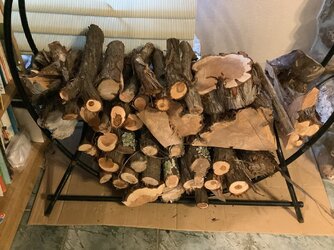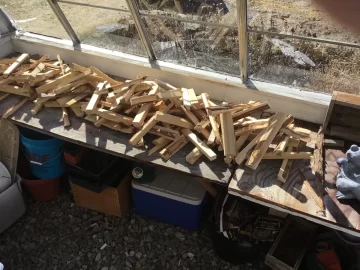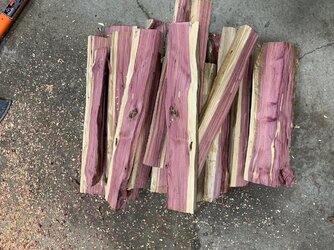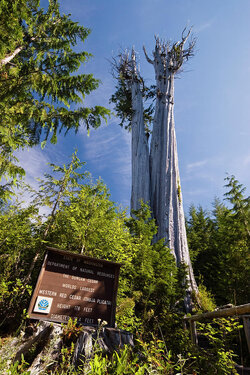Cedar kindling for cat stove?
- Thread starter velocity1
- Start date
-
Active since 1995, Hearth.com is THE place on the internet for free information and advice about wood stoves, pellet stoves and other energy saving equipment.
We strive to provide opinions, articles, discussions and history related to Hearth Products and in a more general sense, energy issues.
We promote the EFFICIENT, RESPONSIBLE, CLEAN and SAFE use of all fuels, whether renewable or fossil.
You are using an out of date browser. It may not display this or other websites correctly.
You should upgrade or use an alternative browser.
You should upgrade or use an alternative browser.
stoveliker
Minister of Fire
I have the same. Yes, it's cedar. Yes it's good to burn, especially as kindling.
Contrary to common belief, pine, cedar, sappy woods are good to burn - IF they are dry enough. (In fact the mfg of my cat stove is in the NorthWest - with mostly sappy trees - and happily burning them.)
Moreover, pine and cedar do dry quickly. So if you're starting out and don't have a good supply of dry wood yet, I'd go get some pine or cherry, split it, stack it, cover it, and if you do that now (before April), you'll be good <20% moisture content come next burning season. Then also get some maple now that may need one-two years to dry. Try to get two (sometimes three for oak) years ahead with your drying. You'll burn well that way.
Contrary to common belief, pine, cedar, sappy woods are good to burn - IF they are dry enough. (In fact the mfg of my cat stove is in the NorthWest - with mostly sappy trees - and happily burning them.)
Moreover, pine and cedar do dry quickly. So if you're starting out and don't have a good supply of dry wood yet, I'd go get some pine or cherry, split it, stack it, cover it, and if you do that now (before April), you'll be good <20% moisture content come next burning season. Then also get some maple now that may need one-two years to dry. Try to get two (sometimes three for oak) years ahead with your drying. You'll burn well that way.
Thanks guys. Always thought to burn something sappy like cedar was considered "dangerous" if that's the main wood you're using. The stuff in the pic I just split from whole pieces today and with my meter its reading 16% so looks ready to rock and roll
I've burned some red cedar splits this winter. Nothing too unusual noted as long as it is dry. It does tend to spark a bit, but burned fine.
Funny part is where the previous owner left this stuff its kind of an eye sore and been wondering what the hell to do with it all. Glad i asked the question, I'll split the rest in the spring and get it mixed in with the other types of wood I have.
Wish I was handy enough to make something cool out of it, almost too pretty to burn lolHa, that's the same way I got the cedar. My next-door neighbor had it laying around and didn't want it. Mixing it in with a denser hardwood is a good plan.
Smells nice too. You could make 1/2" thick cedar hanging blocks to put inside of wool clothes hanging in the closet.
Ashful
Minister of Fire
We've had a few such debates on this forum over the last decade, and the conclusion has been that this oft-repeated advice comes with a caveat. Here's the reasoning:Always thought to burn something sappy like cedar was considered "dangerous" if that's the main wood you're using.
If properly dried, as a few have already stated, these woods can be burned as safely as any other. The trouble comes with the fact that, unlike most hardwoods, cedar and pine tend to also burn pretty well when they're wet. Thus, generations of burning this stuff while still wet has created the real danger of which you have likely heard since you were very young.
Creosote build-up is proportional to the amount of water condensing in your pipe, as you burn. Water droplets form on these particulates, and an excess of moisture will increase the amount which condense on the inside surface of your flue. If the wood is dry(er), more of those particulates are safely ejected from the chimney, before having such opportunity to condense on the pipe.
stoveliker
Minister of Fire
Yes, I've two 5" dia 14" long rounds in my garage, and once couple of years I cut a 0.75" thick disc off of them. My wife keeps it in her closet. After a month or so, I sand the cut faces again and it'll smell like new.
But the majority I've burned. I keep a stash of 1-2" split stuff to burn down coals from oak when I need more heat in cold snaps.
But the majority I've burned. I keep a stash of 1-2" split stuff to burn down coals from oak when I need more heat in cold snaps.
Great idea thanks!Smells nice too. You could make 1/2" thick cedar hanging blocks to put inside of wool clothes hanging in the closet.
Ahh makes sense, thanks for the info!We've had a few such debates on this forum over the last decade, and the conclusion has been that this oft-repeated advice comes with a caveat. Here's the reasoning:
If properly dried, as a few have already stated, these woods can be burned as safely as any other. The trouble comes with the fact that, unlike most hardwoods, cedar and pine tend to also burn pretty well when they're wet. Thus, generations of burning this stuff while still wet has created the real danger of which you have likely heard since you were very young.
Creosote build-up is proportional to the amount of water condensing in your pipe, as you burn. Water droplets form on these particulates, and an excess of moisture will increase the amount which condense on the inside surface of your flue. If the wood is dry(er), more of those particulates are safely ejected from the chimney, before having such opportunity to condense on the pipe.
I’ve burned cords of nothing but cedar. We get some big ones out west. Several feet across. I’d actually prefer pine because I find that there is more soot with cedar. Not tar and not particularly dangerous but an acceleration in normal brown buildup.
Still, hard to waste good fuel.
Still, hard to waste good fuel.
Rob_Red
Feeling the Heat
As stated I would mix it with hard wood, I find cedar likes to pop and spark. I burn pieces of it regularly though.
Ashful
Minister of Fire
I know you have less choice of woods out west, but here we mostly just use cedar as sleepers under piles of logs. Between their short burn time and difficulty in splitting, they stack up pretty poorly among our available choices.I’ve burned cords of nothing but cedar. We get some big ones out west. Several feet across. I’d actually prefer pine because I find that there is more soot with cedar. Not tar and not particularly dangerous but an acceleration in normal brown buildup.
Still, hard to waste good fuel.
On the plus side, they do make good kindling, if you have the hydraulics to split them. And they last damn near forever, I have cedar fence posts marking one of my property lines that may predate my grandfather's birth.
DuaeGuttae
Minister of Fire
I know you have less choice of woods out west, but here we mostly just use cedar as sleepers under piles of logs. Between their short burn time and difficulty in splitting, they stack up pretty poorly among our available choices.
On the plus side, they do make good kindling, if you have the hydraulics to split them. And they last damn near forever, I have cedar fence posts marking one of my property lines that may predate my grandfather's birth.
As a native Virginian who has since moved to Texas, let me point out that trees called cedar in the West tend to be denser than those called cedar in the East. It’s something like 18 to 21 million btu’s versus 12-13 million btu’s. Those numbers are coming off the top of my head as I don’t have time to check, but our land here in Texas is covered with what is called Texas or Mountain Cedar (really Ashe Juniper), and while it is obviously much lighter and seasons much quicker than our Live Oak, it is surprisingly good firewood. We don’t have much that is large enough to split, so we burn a lot of round stem and branch wood, but it gives us easy overnight fires with lots of coals.
If I were back East, I’d still burn cedar if I had it available, though I wouldn’t seek it out to the exclusion of something else. It is great kindling, and it’s also great for putting on top of a bunch of hardwood coals to get a burst of heat while burning down coals during cold snaps. Heed the warnings about the sparks it can throw, though. It does it even when raking coals for a reload.
stoveliker
Minister of Fire
Hm, I have to say that the smaller eastern red cedar I had here (max 6" dia) was easy to split (I did that because I needed it dry enough in one year.) I was actually happy with that. I am now curious to get my hands on a bigger tree to see if I can manageI know you have less choice of woods out west, but here we mostly just use cedar as sleepers under piles of logs. Between their short burn time and difficulty in splitting, they stack up pretty poorly among our available choices.
On the plus side, they do make good kindling, if you have the hydraulics to split them. And they last damn near forever, I have cedar fence posts marking one of my property lines that may predate my grandfather's birth.

I did find it resulted in many "shards", sharp almost shavings that remained attached to the split on one side. I actually cut (rather than "splinter-stabbed) myself quite a few times - resulting in more red/pink wood :-(
I also had cedar of which the white wood on the outside actually did have bugs (powder, holes) in them. So I think it's only the red/pink wood on the inside that's long-lasting?
We still roof houses with it out here. Yes, western red cedar. Huge trees that like to have wet feet so often shallow root systems. Also tend to be hollow when they mature.
Smells great and splits easily.
Smells great and splits easily.
DuaeGuttae
Minister of Fire
Our cedar is smaller down here, but it also has a shallow root system. It has spread so much and taken over so much land that it’s considered a native invasive. It’s harmful to the oak trees because it tends to get the rain water before it has time to make its way down to the deeper oak tap roots. We are clearing a lot of cedar away from oak trees because of that problem.
A lot of ours is pretty young and grows like scrubby bushes, so we have small pieces. At the same time we also can get knotty stumps that can’t be split. We had had one large stump sitting in our barn for a few years, and my husband just got around to noodling it the other week. It was already down to ten percent moisture, and we got ten large chunks out of it. This firewood rack normally stays outside on our deck, but I brought it in for a few days earlier in the month prior to an ice storm. I didn’t want our wood to get coated, and I didn’t want to have to make a trip over ice to get more wood. Our normal wood box was full of oak, so we used the small cedar to burn down coals, but the large chunks turned out to be some amazing firewood, and we used them for overnight burns.

@velocity1 , you mention splitting all your cedar into kindling. While it’s a fine choice, you could also consider leaving some of it fairly large. It should still season. Since it tends to season more quickly than large pieces of hardwood, you can leave it much bigger, just constrained by what fits reasonably in your stove.
I will say that I do have the same experience as @Highbeam that it tends to be sooty. When we burn cedar we see the smoke in the firebox more, but it gets burned up by the secondary combustion before it leaves the chimney. It can leave more brown film on our door corners, though. Your cat should do the same process of burning the smoke.
Enjoy it! A cord of cut wood already on your property and possibly already seasoned is a great thing!
A lot of ours is pretty young and grows like scrubby bushes, so we have small pieces. At the same time we also can get knotty stumps that can’t be split. We had had one large stump sitting in our barn for a few years, and my husband just got around to noodling it the other week. It was already down to ten percent moisture, and we got ten large chunks out of it. This firewood rack normally stays outside on our deck, but I brought it in for a few days earlier in the month prior to an ice storm. I didn’t want our wood to get coated, and I didn’t want to have to make a trip over ice to get more wood. Our normal wood box was full of oak, so we used the small cedar to burn down coals, but the large chunks turned out to be some amazing firewood, and we used them for overnight burns.

@velocity1 , you mention splitting all your cedar into kindling. While it’s a fine choice, you could also consider leaving some of it fairly large. It should still season. Since it tends to season more quickly than large pieces of hardwood, you can leave it much bigger, just constrained by what fits reasonably in your stove.
I will say that I do have the same experience as @Highbeam that it tends to be sooty. When we burn cedar we see the smoke in the firebox more, but it gets burned up by the secondary combustion before it leaves the chimney. It can leave more brown film on our door corners, though. Your cat should do the same process of burning the smoke.
Enjoy it! A cord of cut wood already on your property and possibly already seasoned is a great thing!
Ashful
Minister of Fire
I know there are a few different variants of "cedar", so assumed the stuff I pull out of my woods and hedgerows here may be different than what others call by the same name. Our cedar is a scrubby tall evergreen, shallow roots, and the lower branches die off as they mature. They have 1.5" of white sapwood around a fuschia pink heartwood, and most around here tend to hang in the 8" - 10" DBH range, although some are as large as 14" - 16". The real trouble with using them for firewood, particularly as they get large, is that they seem to put out a million small branches. Those branches knot the trunk up something fierce, to where hand splitting of anything over 8" diameter becomes impractical. They also have shallow roots, and tend to fall over in a storm, if you clear the trees to which they're adjacent. I had probably close to 100 of them blow down in a straight line, an area covering perhaps a football field, when Sandy passed over us in 2012. Because we also had plenty of hardwood blow-down, I let them lay where they fell.
Our cedars tend to be one of the first trees to move in, when a field is left to fallow, such that most of our younger woods are dominated by cedar for a generation. They're replaced thereafter by maples and walnuts, and then eventually oaks and others.
Our cedars tend to be one of the first trees to move in, when a field is left to fallow, such that most of our younger woods are dominated by cedar for a generation. They're replaced thereafter by maples and walnuts, and then eventually oaks and others.
stoveliker
Minister of Fire
Thanks , yeah I decided to split a good portion of it as normal splits and then ill make some kindling on the side. Next thing in order is trying to find a stump lying around on the side of the road i can use to split on lolOur cedar is smaller down here, but it also has a shallow root system. It has spread so much and taken over so much land that it’s considered a native invasive. It’s harmful to the oak trees because it tends to get the rain water before it has time to make its way down to the deeper oak tap roots. We are clearing a lot of cedar away from oak trees because of that problem.
A lot of ours is pretty young and grows like scrubby bushes, so we have small pieces. At the same time we also can get knotty stumps that can’t be split. We had had one large stump sitting in our barn for a few years, and my husband just got around to noodling it the other week. It was already down to ten percent moisture, and we got ten large chunks out of it. This firewood rack normally stays outside on our deck, but I brought it in for a few days earlier in the month prior to an ice storm. I didn’t want our wood to get coated, and I didn’t want to have to make a trip over ice to get more wood. Our normal wood box was full of oak, so we used the small cedar to burn down coals, but the large chunks turned out to be some amazing firewood, and we used them for overnight burns.
@velocity1 , you mention splitting all your cedar into kindling. While it’s a fine choice, you could also consider leaving some of it fairly large. It should still season. Since it tends to season more quickly than large pieces of hardwood, you can leave it much bigger, just constrained by what fits reasonably in your stove.
I will say that I do have the same experience as @Highbeam that it tends to be sooty. When we burn cedar we see the smoke in the firebox more, but it gets burned up by the secondary combustion before it leaves the chimney. It can leave more brown film on our door corners, though. Your cat should do the same process of burning the smoke.
Enjoy it! A cord of cut wood already on your property and possibly already seasoned is a great thing!
This morning I got ot the miter saw and cut up a bin of eastern white cedar. Eastern ( also called northern) white is what we have around here. It has many of good uses including fence posts, shingles and canoe planking. I get long trim and and edgings from a cedar saw mill. What I cut today has a moisture content from 18 to 26% after setting off the ground and under a roof for a few months. That will drop quickly as it thaws and dries in the greenhouse. The pieces that have been stored there are down to under 7% moisture. It has such low density, dries fairly quickly then lights so easily.


Similar threads
- Replies
- 12
- Views
- 1K
- Replies
- 0
- Views
- 351
- Replies
- 13
- Views
- 827
- Replies
- 8
- Views
- 948



